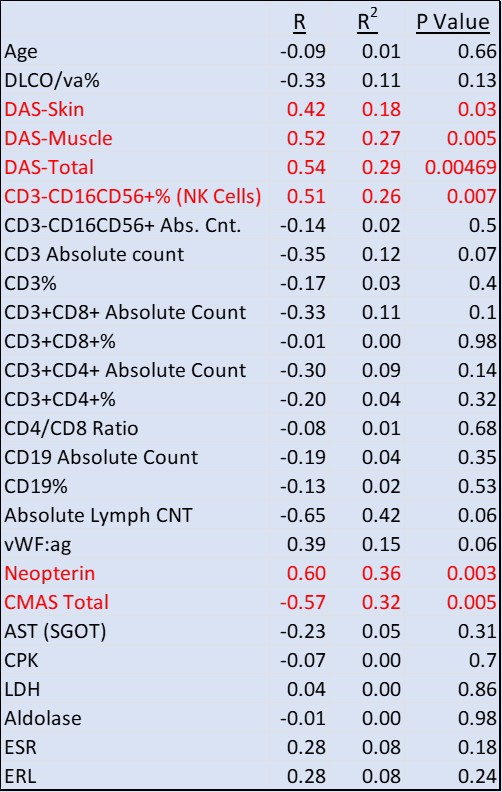Back
Poster Session D
Myopathic rheumatic diseases (polymyositis, dermatomyositis, inclusion body myositis)
Session: (1856–1887) Muscle Biology, Myositis and Myopathies Poster II
1869: Looking for BlyS(BAFF) in Juvenile Dermatomyositis: A New Biomarker of Disease Activity
Monday, November 14, 2022
1:00 PM – 3:00 PM Eastern Time
Location: Virtual Poster Hall
- CC
Christopher Costin, MD
Ann & Robert H. Lurie Children's Hospital of Chicago
CHICAGO, IL, United States
Abstract Poster Presenter(s)
Christopher Costin1, Gabrielle Morgan2, Amer Khojah3 and Lauren Pachman4, 1Ann & Robert H. Lurie Children's Hospital of Chicago, Chicago, IL, 2Ann & Robert H. Lurie Children's Hospital of Chicago and Northwestern University Feinberg School of Medicine, Chicago, IL, 3Umm Al-Qura University, Makkah, Saudi Arabia, 4Northwestern's Feinberg School of Medicine. Ann and Robert H. Lurie Children's Hospital of Chicago; Stanley Manne Children's Research Institute of Chicago, Lake Forest, IL
Background/Purpose: B Cell Activating Factor (BAFF) is a cytokine that drives B Cell proliferation and maturation. B Cells remain an important factor in JDM immune pathophysiology through the production of pathogenic autoantibodies. BAFF has been previously evaluated in the Japanese MDA5-JDM population and found to associate with the presence of rapidly progressive ILD (interstitial lung disease). Here we investigate BAFF in the general North American JDM and its association with commonly accepted measurements of disease activity, disease biomarkers, and the presence of interstitial lung disease.
Methods: We queried the Cure JM Biorepository and Registry which houses patient samples of patients with a diagnosis of JDM or overlap myositis. Serum samples were obtained from a total of 26 patients with a diagnosis of JDM/Overlap myositis half of whom had ILD. Serum samples were also obtained from 13 age-sex matched controls. BAFF levels were measured from serum samples by ELISA. We obtained age, sex, ethnicity, DAS, neopterin, ESR, myositis specific antigen (MSA), and capillary end row loops from the registry for the included myositis patients.
Results: BAFF levels were significantly elevated in the JDM group (1879.5 pg/ml p=0.035) when compared to healthy controls (655.4 pg/ml). As shown in Figure 1, the BAFF levels were found to significantly correlate with DAS, DAS Skin, DAS Muscle, CMAS(childhood myositis assessment scale) and Neopterin by Pearson's correlation coefficient testing. Curiously the BAFF levels did not significantly correlate with B cell number. The patients with ILD were found to have higher BAFF levels but this was not statistically significant (2291 pg/ml vs 1469 pg/ml P=0.47).
Conclusion: BAFF levels were elevated in the JDM population when compared to healthy controls. This finding provides further evidence to support the use of B cell directed therapies such as belimumab or rituximab in the treatment of JDM. The association of BAFF with other markers of disease activity highlights BAFF as a new biomarker of disease activity in JDM.
 Figure 1: Correlations of JDM Characteristics and BAFF
Figure 1: Correlations of JDM Characteristics and BAFF
Disclosures: C. Costin, None; G. Morgan, None; A. Khojah, None; L. Pachman, None.
Background/Purpose: B Cell Activating Factor (BAFF) is a cytokine that drives B Cell proliferation and maturation. B Cells remain an important factor in JDM immune pathophysiology through the production of pathogenic autoantibodies. BAFF has been previously evaluated in the Japanese MDA5-JDM population and found to associate with the presence of rapidly progressive ILD (interstitial lung disease). Here we investigate BAFF in the general North American JDM and its association with commonly accepted measurements of disease activity, disease biomarkers, and the presence of interstitial lung disease.
Methods: We queried the Cure JM Biorepository and Registry which houses patient samples of patients with a diagnosis of JDM or overlap myositis. Serum samples were obtained from a total of 26 patients with a diagnosis of JDM/Overlap myositis half of whom had ILD. Serum samples were also obtained from 13 age-sex matched controls. BAFF levels were measured from serum samples by ELISA. We obtained age, sex, ethnicity, DAS, neopterin, ESR, myositis specific antigen (MSA), and capillary end row loops from the registry for the included myositis patients.
Results: BAFF levels were significantly elevated in the JDM group (1879.5 pg/ml p=0.035) when compared to healthy controls (655.4 pg/ml). As shown in Figure 1, the BAFF levels were found to significantly correlate with DAS, DAS Skin, DAS Muscle, CMAS(childhood myositis assessment scale) and Neopterin by Pearson's correlation coefficient testing. Curiously the BAFF levels did not significantly correlate with B cell number. The patients with ILD were found to have higher BAFF levels but this was not statistically significant (2291 pg/ml vs 1469 pg/ml P=0.47).
Conclusion: BAFF levels were elevated in the JDM population when compared to healthy controls. This finding provides further evidence to support the use of B cell directed therapies such as belimumab or rituximab in the treatment of JDM. The association of BAFF with other markers of disease activity highlights BAFF as a new biomarker of disease activity in JDM.
 Figure 1: Correlations of JDM Characteristics and BAFF
Figure 1: Correlations of JDM Characteristics and BAFFDisclosures: C. Costin, None; G. Morgan, None; A. Khojah, None; L. Pachman, None.

